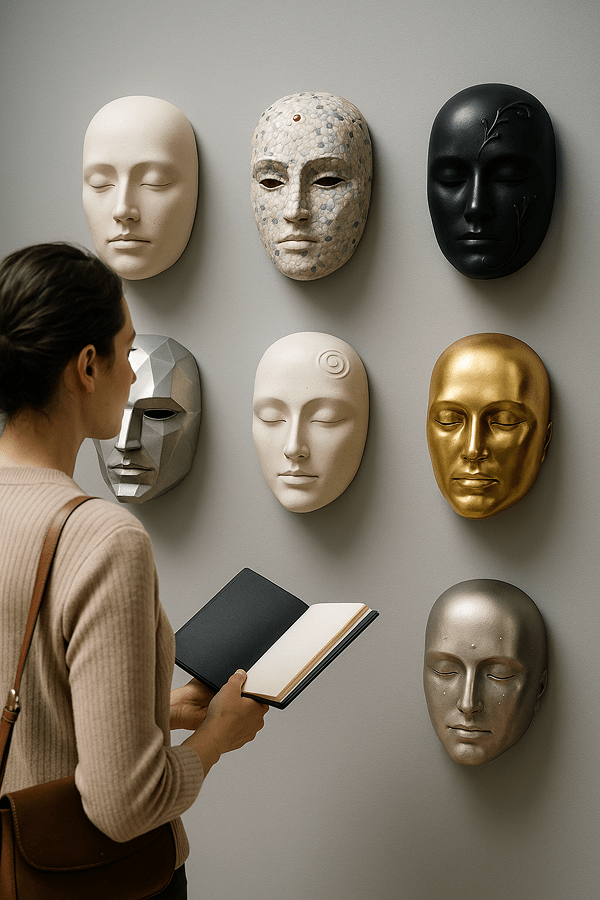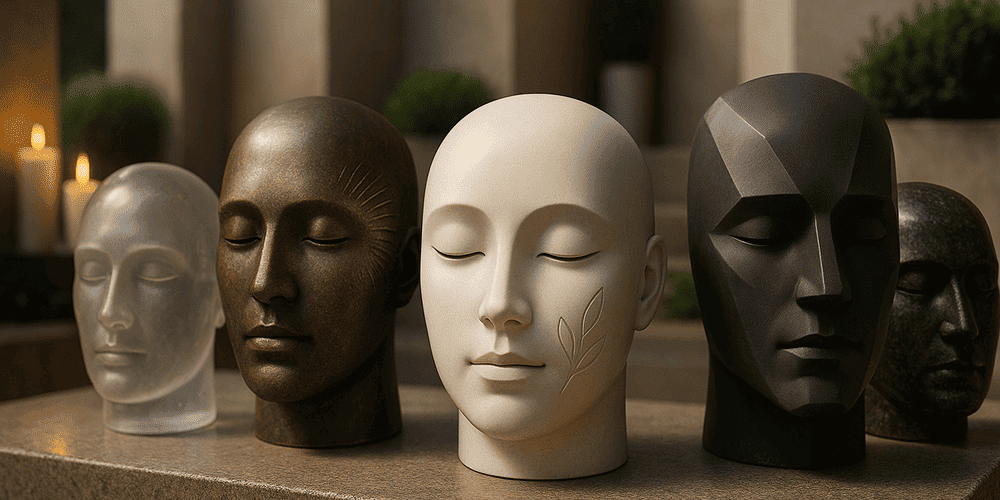Modern Funeral Masks — a contemporary interpretation of ancient mortuary traditions — are designed to memorialize, honor, and protect the deceased in the context of today’s diverse cultures. These masks are characterized by a remarkable variety of styles, from minimalist, monochrome faces to highly stylized or abstract forms with polished surfaces, metallic finishes, or geometric patterns. Many are crafted from innovative materials like resin, glass, polished stone, or metal, and may feature subtle engravings, symbolic motifs, or even digital elements. Modern Funeral Masks are found in cultures worldwide, though they are most commonly encountered in Europe, North America, and parts of Asia, where they emerged as both artistic statements and objects of remembrance in the late 20th and early 21st centuries.
Historical Origins of Modern Funeral Masks
The tradition of Modern Funeral Masks has its roots in ancient funerary practices, but evolved in response to social, technological, and artistic changes of the modern era. The word “mask” comes from the Arabic “maskhara,” meaning buffoon or disguise, evolving through European languages to denote a likeness or covering for the face. While ancient cultures like Egypt and Greece used masks in burial (see Afterlife Masks for more on this tradition), the modern form emerged as a response to changing attitudes toward death and commemoration. In the 19th and early 20th centuries, death masks cast in plaster or wax became popular mementos among artists, scientists, and the elite. The advent of photography and new materials in the 20th century led to innovations in both the design and purpose of funeral masks. Modern masks often blend elements of sculpture, memorial art, and personal tribute, reflecting both individual and collective memory. Notable milestones include the posthumous masks of famous artists and political leaders, as well as contemporary installations that use masks as meditations on mortality and identity.
Cultural Significance and Symbolism of Modern Funeral Masks
Modern Funeral Masks serve as powerful symbols of remembrance, transformation, and the human response to death. In many cultures, the mask represents the enduring presence of the deceased, bridging the worlds of the living and the dead. While earlier masks often depicted idealized or divine features, modern masks may embrace realism, abstraction, or personal symbolism, sometimes even incorporating elements meaningful to the individual or their family. These masks are frequently used in secular memorial ceremonies, art installations, and commemorative exhibitions, as well as in religious rituals. The symbolism of the mask — as a shield, a vessel for memory, or a marker of transition — resonates with contemporary concerns about identity, legacy, and the meaning of mortality. Socially, funeral masks can be used to express collective grief, honor cultural heroes, or spark public conversation about the rituals of death and remembrance. Myths and legends continue to inspire mask artists, while new narratives are created as each mask becomes a unique artifact of the present.
Materials and Craft Techniques of Modern Funeral Masks
The making of Modern Funeral Masks is a fusion of traditional craftsmanship and contemporary innovation. Artists use a variety of materials including resin, glass, ceramics, metal, acrylic, and even biodegradable substances for eco-friendly burials. Techniques range from hand sculpting and casting to 3D printing, laser engraving, and digital modeling. Some masks are minimalist with smooth, monochrome surfaces, while others feature complex engravings, polished metallic finishes, embedded stones, or mixed media elements. Decorative motifs may include abstract symbols, personal memorabilia, or minimalist patterns, with color choices such as white for purity, silver for transcendence, black for mourning, and gold for immortality. Regional differences in style and technique reflect local traditions, artistic schools, and available technologies, resulting in a wide spectrum of visual languages for modern funeral masks.

Functions and Uses of Modern Funeral Masks
Modern Funeral Masks serve a variety of roles, from ritual and ceremonial objects to art pieces and commemorative artifacts. In some cultures, they are used in memorial services, placed on caskets, displayed at wakes, or given as gifts to the family of the deceased. Artists and families may collaborate on the design to reflect the individuality, beliefs, or achievements of the departed. In contemporary art, funeral masks appear in installations, gallery exhibits, and public memorials, serving as meditations on death, loss, and memory. Some are created as part of performance art or digital exhibitions, exploring new ways of engaging with the rituals of mortality. While rarely used in theatrical or festival settings, their influence can be seen in modern stage and film design, where the visual language of the funeral mask continues to inspire. Over time, the use and meaning of modern funeral masks have evolved in tandem with changing attitudes toward death, grief, and commemoration.
Regional Variations of Modern Funeral Masks
Modern Funeral Masks display notable regional diversity, shaped by local customs, artistic trends, and cultural attitudes. In Europe and North America, they tend to favor minimalist, sculptural forms that emphasize reflection and individuality, often integrated into contemporary memorial art. In Asia, especially Japan and South Korea, modern masks may blend ancient burial motifs with sleek, futuristic aesthetics, sometimes incorporating Buddhist or Shinto symbolism. Latin American artists often infuse funeral masks with vibrant colors and folkloric motifs, connecting them to annual festivals of remembrance. African and Oceanic artists may reinterpret traditional funerary motifs using modern materials or abstraction. Each region’s approach reflects its own dialogue between tradition, innovation, and the universal experience of loss.
Famous Examples and Collections of Modern Funeral Masks
Notable Modern Funeral Masks can be found in museums, galleries, and private collections worldwide. Institutions such as the Victoria and Albert Museum (London), the Metropolitan Museum of Art (New York), and the International Mask Museum (Mexico) feature contemporary funeral masks in exhibitions on death and remembrance. Famous examples include posthumous masks of renowned artists, leaders, and cultural icons, as well as contemporary works by leading sculptors and mask-makers. Private collections and online resources like toddmasks.com offer virtual galleries, high-resolution photography, and expert commentary, making these powerful artifacts accessible to a global audience. Important recent exhibitions have explored the intersection of funerary masks, memorial art, and personal identity in the 21st century.
Influence of Modern Funeral Masks on Art and Culture
Modern Funeral Masks have had a significant impact on visual art, design, film, and public memory. Their forms and symbolism inspire contemporary sculptors, installation artists, and designers exploring identity, mortality, and the boundaries between life and death. In literature and cinema, funeral masks often symbolize the struggle to remember and honor the deceased, as well as the search for meaning in mortality. Modern mask motifs appear in jewelry, architecture, and stage design, while digital artists use the language of masks to explore virtual memorials and online remembrance. The preservation and reinterpretation of funeral mask traditions play a crucial role in maintaining cultural heritage and sparking dialogue about death, loss, and creativity. Afterlife Masks, rooted in ancient traditions, provide a fascinating parallel for understanding the evolution of funerary art into the modern era.

Contemporary Status and Preservation of Modern Funeral Mask Traditions
Today, Modern Funeral Masks are the subject of ongoing artistic, academic, and cultural interest. Mask-makers, artists, and memorial designers continue to innovate, blending traditional skills with new materials and digital technology. Museums, universities, and cultural organizations support research, exhibitions, and educational programs that engage the public with the art and meaning of funeral masks. Workshops, masterclasses, and online resources — such as toddmasks.com — help to transmit knowledge and foster appreciation among new generations. Ethical collecting, conservation, and documentation are emphasized to ensure the dignity, respect, and accessibility of these contemporary artifacts for future generations.
Collecting and Acquiring Modern Funeral Masks
The market for Modern Funeral Masks is dynamic and varied, with contemporary pieces, artist-signed works, and innovative designs available from mask-makers, galleries, and online shops. Prices range widely, depending on materials, craftsmanship, provenance, and the reputation of the artist. Collectors are encouraged to seek expert advice, verify authenticity, and support ethical sources that respect the memory and dignity of the individuals commemorated. Museums and galleries often offer certified reproductions and educational kits. Toddmasks.com provides expert guidance on collecting, authentication, and understanding the significance and context of modern funeral masks. Responsible collecting contributes to both artistic innovation and the preservation of funerary heritage.
